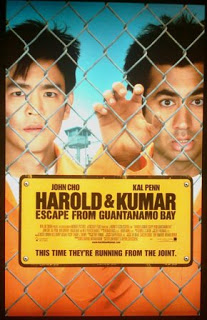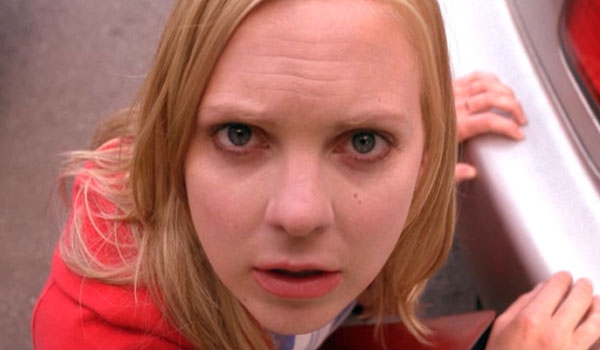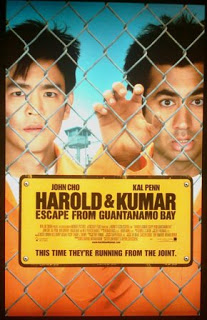Naturally, Harold and Kumar are accused of working together as a “North Korea and Al Qaeda alliance,” and they get shipped off to Guantanamo Bay. All this happens within the first 15 minutes of the film, and by the 20-minute mark, they’ve already escaped Guantanamo. The rest of the film follows their wandering across the United States, looking for a way to prove to the paranoid government that they aren’t, in fact, terrorists.
Because the first film was such an unexpected surprise in its intelligent dissection of both racial stereotypes and stoner culture (ha, seriously), I was excited about seeing the sequel. Unfortunately after sitting through most of the movie feeling somewhat uncomfortable, I left the theater entirely enraged.
 To say this film is misogynistic is an understatement. What most upset me wasn’t merely that women were unnecessarily objectified (I can’t remember the last time I saw so much gratuitous nudity), or that women were basically one-dimensional morons (and were given some of the most ridiculous dialogue I’ve heard in awhile, which is saying a lot in the age of Judd Apatow).
To say this film is misogynistic is an understatement. What most upset me wasn’t merely that women were unnecessarily objectified (I can’t remember the last time I saw so much gratuitous nudity), or that women were basically one-dimensional morons (and were given some of the most ridiculous dialogue I’ve heard in awhile, which is saying a lot in the age of Judd Apatow).
What bothered me most was that I couldn’t help but laugh at and appreciate the subversive way the film deals with race; the writers manage to satirize traditional perceptions of racial groups by using stereotypes to reveal the ridiculousness of racial stereotypes (yeah, I just defined satire), but for some reason, the writers couldn’t manage to treat traditional stereotypes of women with the same care.
While the audience laughs with the characters when race is addressed (when an old white woman on a plane stares at Kumar in fear, he morphs into a terrorist right before her eyes, complete with full beard and turban), the audience laughs at the female “characters” (like when two prostitutes, confronted with the question, “Have you found the love of your life?” get all ditzy and say, “No, we’re whores!”). Welcome to the films of the millennium: if we’re talking about race, forget about gender (see also Black Snake Moan, Hustle & Flow, maybe even Borat).
Two of the more extreme examples of sexism in the movie are scenes involving gratuitous female nudity (“the bottomless party”) and clichéd portrayals of prostitutes in a brothel.
The Bottomless Party
You know you’re in for a real treat when Harold and Kumar show up at a pool party where all the women walk around completely naked—oh, except for their tops. When they enter their friend’s mansion, in hopes of getting some help in avoiding Guantanamo again (they’ve escaped by now), they’re confronted with an array of tanned women’s asses and barely-there pubic hair, and whose mouths are wide open. In similar reaction, the group of men sitting next to me in the theater couldn’t stop making comments (“yeah man, hit that, daaaaaamn, that’s what I’m talkin’ about”), and this scene lasted at least seven hours from my perspective.
My favorite part of the scene was when one of the women started to take her top off, and the host responded with something along the lines of, “What the hell do you think you’re doing? Put your top back on; I don’t know what kind of party you think this is … ” Of course, she rolled her eyes as if to say “silly me” and apologized while covering her breasts. The audience got a terrible kick out of that. Because, if you didn’t know, it’s hilarious to watch women walk around naked while men tell them what they can and can’t do with their bodies. Sure, in the final moments of the scene, Harold and Kumar pull down their pants, but then the camera cuts away. What, no cock-shot?
The Brothel
Neil Patrick Harris is gay in real life, so I’m still coming to terms with Neil Patrick Harris supposedly playing himself, when what he’s really doing is playing 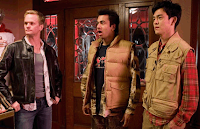 a heterosexual, drug-addicted character named Neil Patrick Harris. Regardless. Neil insists on taking Harold and Kumar to a brothel to get [insert several degrading comments about screwing women here]. Harold refuses, instead choosing to sit with a group of prostitutes, who he then complains to about his devolving friendship with Harold, while the prostitutes console him. (It’s unfortunate here that the writers rely so heavily on conventional clichés regarding “the hooker with a heart of gold” stereotype and the mother/whore fantasy.) Kumar, of course, takes two prostitutes into a room, while Neil goes through several choices before deciding on the one with the biggest breasts.
a heterosexual, drug-addicted character named Neil Patrick Harris. Regardless. Neil insists on taking Harold and Kumar to a brothel to get [insert several degrading comments about screwing women here]. Harold refuses, instead choosing to sit with a group of prostitutes, who he then complains to about his devolving friendship with Harold, while the prostitutes console him. (It’s unfortunate here that the writers rely so heavily on conventional clichés regarding “the hooker with a heart of gold” stereotype and the mother/whore fantasy.) Kumar, of course, takes two prostitutes into a room, while Neil goes through several choices before deciding on the one with the biggest breasts.
Kumar gets his girls to make out with each other, but then bursts into tears about his ex-girlfriend marrying some government-employed douchebag. So we’ve got two naked women sitting on either side of him, consoling him, helping him feel better about himself just after they’ve made out with each other—what more could a guy want? Is it just me, a feminazi audience member, who’s expecting too much? Maybe I’m over-analyzing. Maybe this is funny. They’re just whores after all. And Neil reminds us ever-so-subtly by literally branding his giant-breasted whore’s ass.
Throughout the film, the audience can’t help but be positioned as a collective participant in this sexism, and while I appreciated the intelligent discussion of post-9/11 race relations, I couldn’t 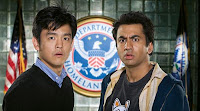 help but hate the film’s mistreatment of women. The writers had many opportunities to complicate gender issues, and yet, as always seems to be the case in films geared toward male audiences, they chose to exploit the women instead, turning them into nothing but naked body parts; their only importance is the fulfillment of male desires. I hated that. And I hated how, when I got up to leave the theater, the group of men sitting next to me talked about needing to wait out their hard-ons before they could stand up to leave.
help but hate the film’s mistreatment of women. The writers had many opportunities to complicate gender issues, and yet, as always seems to be the case in films geared toward male audiences, they chose to exploit the women instead, turning them into nothing but naked body parts; their only importance is the fulfillment of male desires. I hated that. And I hated how, when I got up to leave the theater, the group of men sitting next to me talked about needing to wait out their hard-ons before they could stand up to leave.
